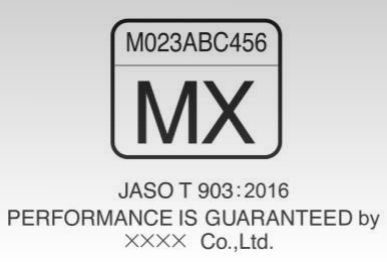TheJapanese Automotive Standards Organizationupdated its four-stroke motorcycle engine oil standard with redefined clutch friction parameters and a new reference friction plate and reference oils for testing. Meanwhile, a long-awaited gear-pitting test is still unformed.
Jasos T903 four-stroke oil specification was developed in 1998 and has since been followed globally where Japanese motorcycles are popular. Before its revision last month, T903 had been updated several times – most recently in 2011.

Image: Japan Society of Automotive Engineers
To show that an oil meets the Jaso T903:2016 voluntary standard, lube marketers must show this designation mark on the product, with performance class and company name.
The industry had been waiting for an update since the 2011 version caused miss-categorization of several frictional properties, said Infineum International regional marketing manager Nick Burton during an event preceding this year’s Uniti Mineral Oil Technology Congress held in Stuttgart, Germany.
After the introduction of Jaso T903:2011, several companies reported that oils were incorrectly categorized as MA, MA1 and MB, Burton said at the Infineum Trends presentation in April. The standards MA, MA1 and MA2 performance grades are for four-cycle motorbikes with wet clutches and the MB grade is for scooters with automatic transmissions. Each category has its own ranges for dynamic friction, static friction and stop time index performance attributes.
It was pointed out that, in some cases, the evaluation results of friction characteristics differed before and after the 2011 revision, thus the test conditions for the friction characteristic test was reviewed, Jasos revised manual noted. Since the friction plate and the reference oils used for the evaluation test were the factors that would change the friction characteristic, these new alternative items and new test conditions were investigated.
Formulators choosing to meet the voluntary standard will now test their products against new reference oils and a new friction plate. Oils meeting the 2016 standards will be allowed to display a new logo starting Oct. 1.
Jasoalso tweaked the limits for the standards clutch system friction test. For example, the 2011 version required MA1 oils to score between 1.50 and 1.85 on the dynamic friction characteristic index. The updated standard narrows the qualifying window for that performance class to between 1.35 and 1.50. A full list of the parameters can be found on page 16 of therevised manual.
The industry is still waiting for a test that measures an oils ability to prevent gear pitting, Burton noted. Jaso, which is part of Japan’s Society of Automotive Engineers, has been working on such a test for several years, but did not complete it in time for the recent T903 revisions. We are facing some challenges with the development of a test for gear pitting, a JSAE official told Lube Report Asia. For this round, in order to give priority for amendments in the testing of the clutch for T903, the inclusion of a gear pitting test method was deferred.
The need for a pitting test is driven primarily by two trends, Burton explained. First, the industry is moving towards thinner oils to improve fuel economy. Motuls Franois Dol noted in a recorded video segment of the presentation that the lowest viscosity original equipment manufacturers currently recommend for their top-performing bikes is 10W-30, and that there is still some room to reduce viscosity even further. In that case, wear control will be more and more of a challenge. It will be vital to introduce a pitting test that is relevant to the wear conditions experienced in a bike.
The second factor possibly leading to increased pitting is an oils level of phosphorus, which is found in many types of anti-wear additives. Phosphorus levels may need to be reduced because the element could taint emissions control systems, which are being increasingly installed on new motorcycles as well as commercial and passenger vehicles. Yet formulators are still awaiting guidelines on suitable levels of phosphorus, Burton said.
We think eventually we have to lower the phosphorus level, the JSAE official continued. For two-wheelers, although the effects on the reliability of the engine are big, currently we are unable to determine [a suitable] level of phosphorus. We will establish a gear pitting test and then determine the effect on the reliability of the engine before looking into the lowering of phosphorous levels.
Motorcycle sales are projected to grow by up to 6 percent to reach more than 132 million units by 2018, Burton said, with OEMs from the top three producing countries – Japan, China and India – set to hold their collective market share of 75 percent of worldwide sales (Japans share is 41 percent, Chinas 37 and Indias 15).
Asia-Pacific is by far the largest [motorcycle] market, with more than 70 percent of the worlds 550 million bikes on its roads, and sales running into the tens of millions, Burton pointed out.
United Kingdom-based Infineum has recently completed several expansion projects in the Asia-Pacific region and is regarded as one of the world’s four largest additive suppliers.
Lam Lye Ching contributed to this article.